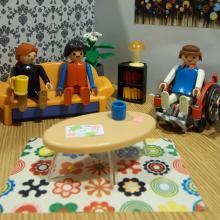This guide highlights elements that need to be considered when running an experience lab, and how this methodology could be evaluated. Two supporting case studies (working with outcomes and roles and boundaries) are also available which explore the experiences of those involved.
What is an experience lab?
Labs are safe spaces that support people to experiment. This methodology has been used to experiment with citizen-led ideas, people's experiences, data and digital technology, systems and processes within services1,2,3,4 and in social care educational settings.
People from the social services sector told us they would like to experiment with different ways to improve people's experiences when communicating with others. We, therefore, ran two labs which explored how people could engage with one another differently, reflected on how this made them feel, and what they may do differently as a consequence of this experience.
This was a small exploratory project. Of the two labs we ran one created the experience our partners wanted to experiment with, and the other did not (we explain why this happened in the case studies that accompany this guide8). However, both labs delivered positive outcomes for the people involved. Consequently, we believe this methodology offers social services an opportunity to accelerate changes in the way people work together. However, more evidence is needed to substantiate this view. We would like to hear from you if you apply this methodology in practice and have outcomes to share.
Why run an experience lab?
They believed cultural, social, systemic and service processes created barriers to improving the way people work together. They also identified that people's knowledge, expectations, roles and responsibilities could act as barriers to change in practice. For these reasons our partners invited people who perceived the change sought as risky to take part in the lab. This meant we used this methodology to offer people the opportunity to a) think about changes in practice they would like to experience; b) test what they think needs to change to realise this experience; c) reflect upon this new experience; and d) learn from what worked/what needs to be improved.
Creating an experience
Consider key elements that need to 'come together', such as other people, processes, location and resources. You may want to co-design this with the people whose experiences you wish to affect using our suggested project framework. Other than knowledge of the context you also need to:
- Understand what needs to change to ensure people have a new experience
- Be aware of the support/training people may need to 'get ready' for the lab
- Support people to feel comfortable with the idea of an experiment and work with other people involved in the lab
Designing your lab
- Focus upon one experiential perspective
- Be able to explain what you want to test in one sentence
- Only involve people who have experience/knowledge of the situation you want to change
- Ensure that people understand this is an experiment and will not affect the care or support they receive, but could benefit people who access support in the future
- Create/adapt/use products and tools to support this experience to be realised
- Test this experience in a safe, live environment (or create an aspirational environment)
- Make time for personal and group reflection
Key pointers for success
- Some of the ways we supported people to get ready for the experience lab and designed the lab itself were successful and others were not. Reflecting on this has enabled us to identify key pointers when using this methodology.
- If you provide support or training prior to the lab be careful not to encroach on the experience you would like people to have in the lab. Not all experiences are educational8. Time needs to be provided so people can consider and reflect upon their actions and feel safe enough to do this together.
- Not all experiences are positive. Judge people's perceptions of risk and capabilities. Design the lab so that these risks feel real but people feel supported.
- Where it may be too sensitive for people to use their own life experiences in a lab, support people to develop personas and scenarios they can act out. However role play activities are not easy for all. Consider people's ability and readiness to engage in this kind of activity.
- Include a mixture of people with different skills, knowledge, experience and capabilities. This supports people to learn from one another.
- Include people from various areas of the organisation/service/community you are working with. This can help with the spread and scale of the change you aim for.
Endnotes
- Mulgan G (2014) The radicals dilemma: an overview of the practice and prospects of social and public labs - version 1, London: NESTA
- Chan T (2014) Landscape of innovation labs, Bridgespan Group
- Desai A (2014) How are we defining social innovation labs? Bridgespan Group (https://twitter.com/adarshdesai/status/470926641439322112/photo/1)
- Public Service Innovation Labs #psilabs
- Robert Gordon University (2014) Clinical home setting, clinical and practice facilities
- Iriss (2014) Core elements of an experience lab project, Glasgow, Iriss
- Iriss (2014) What is the difference between a lab and a workshop?, Glasgow, Iriss
- Dewey J (1997) Experience and education, Pocket Books
- Iriss (2014) Working with outcomes: the practitioner experience and Exploring roles and boundaries: the prisoner and prison officer experience, Glasgow, Iriss
Written by: Gayle Rice and Fiona Munro
Photography by: Gayle Rice and Ian Phillip
PLAYMOBIL figures used with kind permission of Geobra Brandstätter GmbH & Co. KG, Germany. PLAYMOBIL is a registered trademark of Geobra Brandstätter GmbH & Co. KG, for which also the displayed PLAYMOBIL toy figures are protected.








